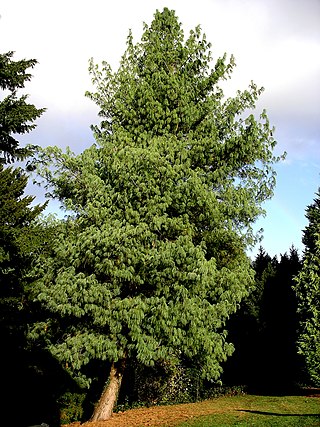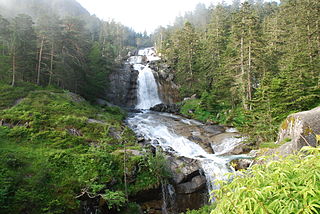
Pinus sylvestris, the Scots pine (UK), Scotch pine (US), Baltic pine, or European red pine is a species of tree in the pine family Pinaceae that is native to Eurasia. It can readily be identified by its combination of fairly short, blue-green leaves and orange-red bark.

Pinus nigra, the Austrian pine or black pine, is a moderately variable species of pine, occurring across Southern Europe from the Iberian Peninsula to the eastern Mediterranean, on the Anatolian peninsula of Turkey, Corsica and Cyprus, as well as Crimea and in the high mountains of Northwest Africa.

The Torrey pine is a rare pine species in California, United States. It is a critically endangered species growing only in coastal San Diego County, and on Santa Rosa Island, offshore from Santa Barbara in Santa Barbara County. The Torrey pine is endemic to the California coastal sage and chaparral ecoregion.

Picea abies, the Norway spruce or European spruce, is a species of spruce native to Northern, Central and Eastern Europe.

Pinus contorta, with the common names lodgepole pine and shore pine, and also known as twisted pine, and contorta pine, is a common tree in western North America. It is common near the ocean shore and in dry montane forests to the subalpine, but is rare in lowland rain forests. Like all pines, it is an evergreen conifer.

Pinus parviflora, also known as five-needle pine, or Japanese white pine, is a pine in the white pine group, Pinus subgenus Strobus, native to Japan.

Pinus wallichiana is a coniferous evergreen tree native to the Himalaya, Karakoram and Hindu Kush mountains, from eastern Afghanistan east across northern Pakistan and north west India to Yunnan in southwest China. It grows in mountain valleys at altitudes of 1800–4300 m, reaching 30–50 m (98–164 ft) in height. It favours a temperate climate with dry winters and wet summers. In Pashto, it is known as Nishtar.

Coulter pine, or big-cone pine, is a native of the coastal mountains of Southern California in the United States and northern Baja California in Mexico. Isolated groves are found as far north as Clearlake, California on the flanks of Mt. Konocti and Black Diamond Mines Regional Preserve. It is named after Thomas Coulter, an Irish botanist and physician. The Coulter pine produces some of the heaviest cones of any pine tree, up to 5 kg (11 lb) and among conifers is exceeded only by the cones of Araucaria bidwillii.

Pinus ponderosa, commonly known as the ponderosa pine, bull pine, blackjack pine, western yellow-pine, or filipinus pine, is a very large pine tree species of variable habitat native to mountainous regions of western North America. It is the most widely distributed pine species in North America.

Pinus leiophylla, commonly known as Chihuahua pine, smooth-leaf pine, and yellow pine, is a tree with a range primarily in Mexico, with a small extension into the United States in southeast Arizona and southwest New Mexico. The Mexican range extends along the Sierra Madre Occidental and Sierra Madre del Sur from Chihuahua to Oaxaca, from 29° North Lat. to 17°, between 1600 and 3000 meters altitude. It requires about a rainfall 600 to 1000 mm a year, mostly in summer. It tolerates frosts in winter.

Pinus sibirica, or Siberian pine, in the family Pinaceae is a species of pine tree that occurs in Siberia from 58°E in the Ural Mountains east to 126°E in the Stanovoy Range in southern Sakha Republic, and from Igarka at 68°N in the lower Yenisei valley, south to 45°N in central Mongolia.

Pinus heldreichii, the Bosnian pine or Heldreich's pine, is a species of pine native to mountainous areas of the Balkans and southern Italy.

Pinus monophylla, the single-leaf pinyon, is a pine in the pinyon pine group, native to North America. The range is in southernmost Idaho, western Utah, Arizona, southwest New Mexico, Nevada, eastern and southern California and northern Baja California.

Cedrus atlantica, the Atlas cedar, is a species of tree in the pine family Pinaceae, native to the Rif and Atlas Mountains of Morocco, and to the Tell Atlas in Algeria. A majority of the modern sources treat it as a distinct species Cedrus atlantica, but some sources consider it a subspecies of Lebanon cedar.

The woodlands of the Iberian Peninsula are distinct ecosystems on the Iberian Peninsula. Although the various regions are each characterized by distinct vegetation, the borders between these regions are not clearly defined, and there are some similarities across the peninsula.

The Néouvielle massif is a group of mountains in the Pyrenees in France notable for its lakes and its microclimate. Much of the massif lies within the 23.13 square kilometres (8.93 sq mi) Néouvielle National Nature Reserve; this nature reserve was created in 1936 and is the third oldest in France.

The Pyrenees conifer and mixed forests is a temperate broadleaf and mixed forests ecoregion in southwestern Europe. It extends along the Pyrenees mountains which run east and west along the border between France and Spain, and includes all Andorra. The ecoregion extends from the lower slopes of the Pyrenees to its highest peaks, which include Aneto, Posets, and Vignemale.

The Alps conifer and mixed forests is a temperate broadleaf and mixed forests ecoregion in central Europe. It extends along the Alps mountains through portions of France, Italy, Switzerland, Germany, Liechtenstein, Austria, and Slovenia. The ecoregion extends from the lower slopes of the Alps to its peaks, which include Mont Blanc, at 4,809 m (15,778 ft) the highest peak in the Alps.

Pinus × rhaetica, commonly known as Rhætic pine, is a natural hybrid of mountain pine and Scots pine. It is a coniferous tree nothospecies located in the subsection Pinus. The species name refers to the Rhætica alps, located in eastern Switzerland and western Austria.

Pinus washoensis, the Washoe pine, is a rare, semi-disputed species of large-sized conifer in the family Pinaceae. The species was described by Herbert Louis Mason and William Palmer Stockwell in 1945. It is in the Pinussubsect. Ponderosae with the Ponderosa pine.






























